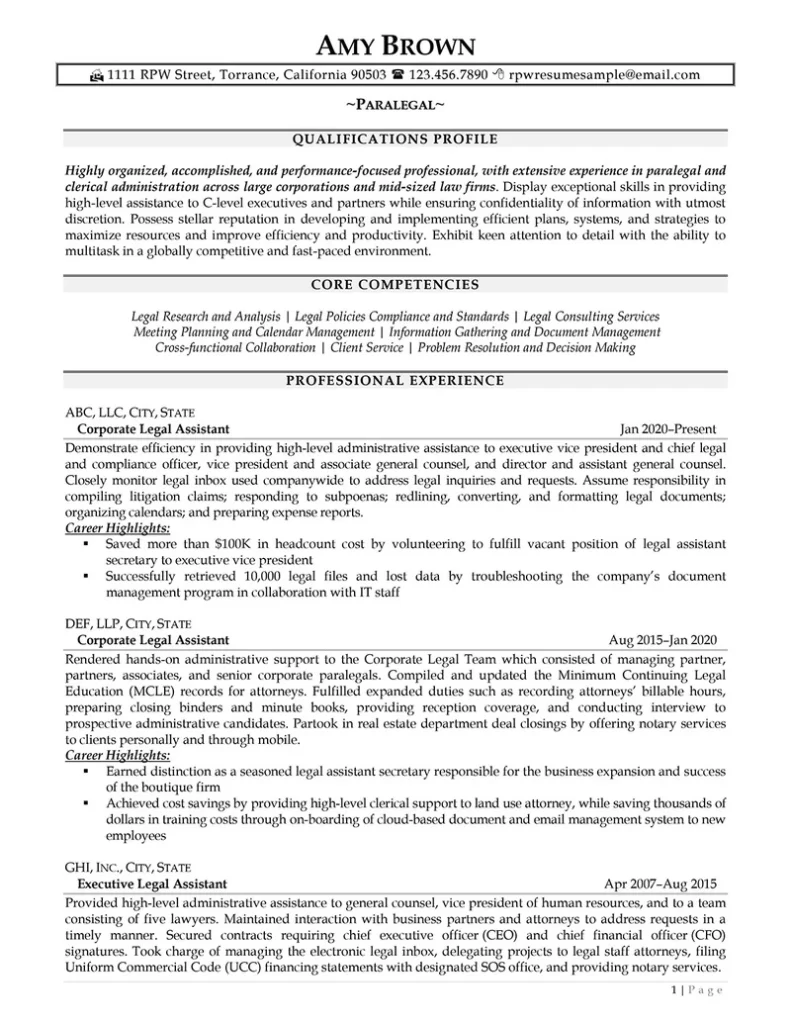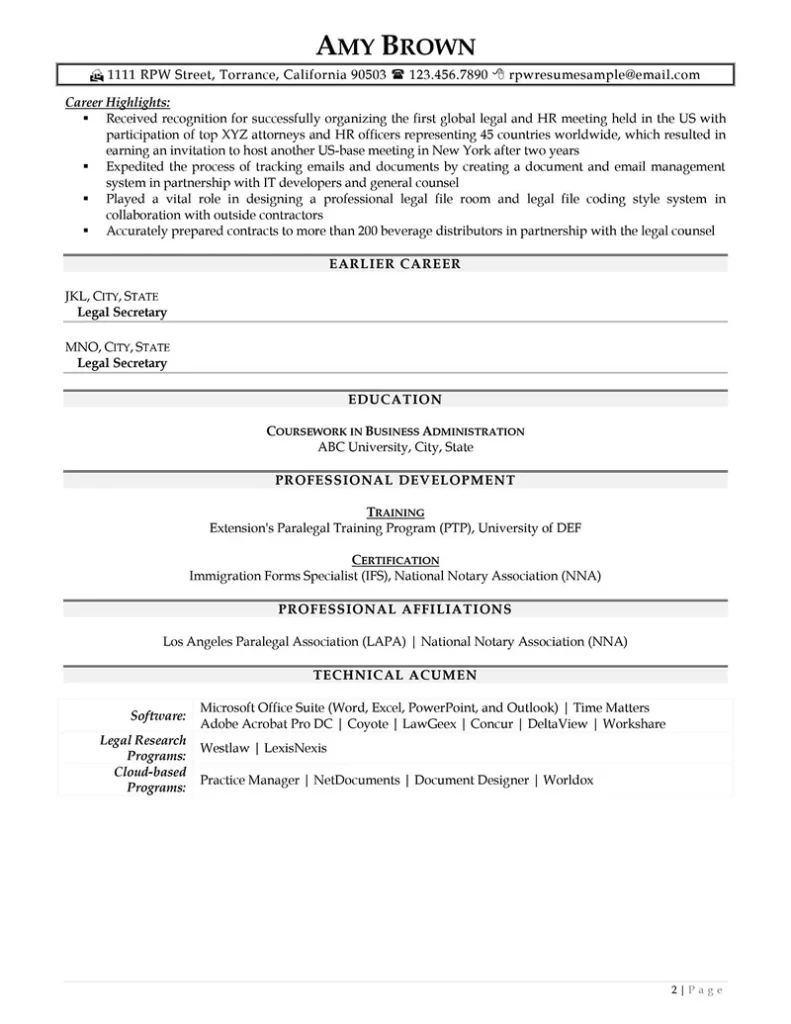As a job seeker, you know that it’s highly crucial that you have a professional paralegal resume. This serves as one of your tools to best equip you in letting a hiring manager know about your past work, giving an idea of what you can bring to the table.
As per the U.S. Bureau of Labor Statistics (BLS), the outlook for paralegal jobs is expected to grow 12% from 2020 to 2030. This is well faster and higher than the average for all jobs. In fact, about 43,000 jobs are projected each year on average over the decade. Many of these are due to the need to replace workers who shift to other careers or exit the labor force, such as retirement.
So, choosing this path means you’re on your way to building a rewarding career. With that in mind, it’s best to keep up with the latest resume trends and ensure that your job search tools stand out to help you land the job you desire. Read on to know more about this career, what to include and how to write your job search tool, and how an expert can take care of your resume so that you won’t need to go through the process alone.
What is a Paralegal?
A paralegal performs various tasks aiming to support lawyers and other legal experts. They are not licensed to practice law in most jurisdictions. Moreover, they must always do their duties under the direct guidance of an attorney. It’s also worth noting that some of them focus on one area of law.
What are the Most Common Paralegal Duties?
Some of their main duties are:
- Drafting legal documents
- Doing factual and legal research
- Reviewing and summarizing records
- Filing documents with the court
- Maintaining files
- Helping lawyers prepare for trials
- Communicating with clients
- Giving behind-the-scenes support in the courtroom at hearings and trials
- Investigating the facts of a case by interviewing clients and witnesses
How Do You Become a Paralegal?
Most paralegals have an associate degree or a certification from an accredited program in legal studies. In some cases, some lawyers opt to hire college graduates with no specialized education or legal background yet and then train them on the job. Job opportunities open to paralegals are not limited to law firms, though many of them work in the legal services sector. Some of them also work in justice, public order, safety, and insurance firms to name a few.

What to Include on Your Paralegal Resume
Now, what should you do to ensure your resume contains the basics and most needed parts? Use this as your guiding checklist so that you won’t miss anything out.
Updated Contact Details
These should be put at the top part of your resume. It’s best to put your full name in a large and bold font, followed by your professional email address below it. Then, place your phone numbers and you may also include your mailing address.
Strong Profile Intro
On average, recruiters quickly scan a resume in under 10 seconds. This is where they check to see if an applicant can go past the first screening and get moved to the next step. Thus, you must ensure that your intro captures the attention of your reader.
To do this, mention and highlight your core skills, experience, and winning traits. Though, don’t overdo it. It’s best to keep this part from 1 to 3 sentences long. As they say it, keep it short and sweet.
🔍 Think Your Resume’s Fine? Let’s Double-Check That
Even strong resumes can miss critical details—especially when it comes to passing Applicant Tracking Systems (ATS). Our specialists offer a free review to uncover gaps, improve formatting, and ensure your resume is ATS-ready and recruiter-friendly.
Based on which type suits your job level, you may choose to write one of these:
- Paralegal resume summary
- Paralegal qualifications profile
- Paralegal resume objective
Detailed Work History
Writing this part of your resume goes beyond just merely listing your past jobs. Instead, treat this as your chance to showcase the top duties you had in detail. This way, you can tailor your resume to the job must-haves. Just don’t forget to state the name and location of your past employers and the inclusive dates of your tenure.
Key Awards and Accomplishments
Under each job you have previously held, list your career highlights in bullet points. Aside from your top duties, your feats help better contextualize the kind of work and value you have brought throughout your career. A bonus benefit of that is hiring managers can get a better sense of how you perform as a professional.
Top Paralegal Skills
Apart from being honest on listing only the skills that you have, make sure that your skills section matches the required skill sets in the job posting.
Check out these lists of the kind of skills to put in your resume:
Technical Skills
- Microsoft Office Suite
- Westlaw
- Worldox
- Workshare
- Concur
- Intuit QuickBooks
Hard Skills
- Case management
- Court calendaring
- Legal knowledge, research, and writing
- Trial preparation
Soft Skills
- Attention to detail
- Social skills
- Multitasking
- Flexibility
- Organizational skills
- Time management
- Research skills
- Trustworthy
- Excellent judgment skills
- Teamwork
Detailed Academic Background
While most firms accept those with various levels of education, you should ensure that this part of your resume is clear and aligned to the kind of career path you aim to take.
Hence, you must not forget to put:
- Type of your degree;
- Your major;
- The name and location of your school; and
- Your top awards, honors, and other feats.
Other Key Details
You may also consider adding other sections that you deem fit to your application. If you want to highlight your core competencies early on, you can allot a space for this after your intro. Toward the end of your resume, adding a list of your technical acumen can also work.
On top of these, it’s key to mention any training, certifications, and affiliations you have.

How to Write a Paralegal Resume
Having covered the key parts and points you must include, it’s now time for you to know how to craft your resume. Heed these foolproof tips to get you started!
Pick the appropriate resume format.
To write a resume that looks polished and well-put, ensure you’re using a cohesive resume format for that. While there are various ones you can choose from, you may opt to use one of these:
- Reverse Chronological Format. Starting from your most recent job, work your way backwards. This serves as the best option if you aim to pursue the same career path you’ve started.
- Functional Format. Shed light on your skills as your winning strengths above your other feats no matter the job posts you’ve held in the past. In most cases, this type is used for those who have career gaps or who aim to change careers.
- Hybrid Format. Mixing the first two formats above, this aims to stress your past roles and skills to prove your background. Experts don’t suggest using this approach if you don’t have key work history yet.
If you’re still unsure which one you should go for, you may check out our detailed guide on choosing the best resume format for your case.
Ensure your resume is tailored to the job.
There may be times you might feel tempted to just send a generic job search tool to various firms. Doing this won’t help you get noticed more by recruiters.
As a paralegal, one of your top soft skills is attention to detail. You must also apply this when you’re job hunting. As you write your resume, make sure you have a clear sense of what the job posting requires and what the recruiter looks for in a candidate. You may start by checking out the job description, look for the top requirements, and if those match your profile, put them in your resume as well.
Enhance it with action verbs and keywords.
Since most firms now use applicant tracking systems (ATS) to screen resumes, you have to ensure that yours will pass through! Do this by reading the job description carefully. Then, check if there are tasks that you’ve done before in your career, and make sure to state them using resume keywords and action verbs. Some samples are:
- Rendered
- Compiled
- Fulfilled
- Partook
- Secured
- Took charge of
Check its format and layout.
Follow the standard ways how to format your document. Here are some quick pointers:
- Use a 1- to 1.5-point spacing to give it enough space between lines of text.
- For normal texts, use 11 to 12-point font sizes. Meanwhile, larger fonts used for section titles and headers must be at 14 to 16 points. Make sure to use font types that are easy to read, too!
- You may also use bold, larger texts to show your file’s section title and headers.
Review your file.
Lastly, do a final run-through for grammar errors and typos before saving your file and sending it. Further, you may edit out some parts you think aren’t fit for your application.
You may also opt to have your peer check your resume for you and ask for feedback on things you might be able to enhance or remove as needed.
Paralegal Resume Sample
Another great way for you to get a better grasp of how you should write your own is to review paralegal resume examples. In fact, we’ve got the best one for you! Use this sample to serve as your guide as you craft your resume.


Let Experts Write Your Paralegal Resume
Your job search can be as tough as the competition you’ll face once you put your application out there. Fret not; career experts from Resume Professional Writers are here to back you up! Choose from our best resume writing services and see what best suits your needs. You may also contact us to know more about what we can offer to give your career a boost.
If you already have an existing resume, get a free resume review straight from our career coaches. What’s more, we’ve got other expert tips and career help blogs, too!








